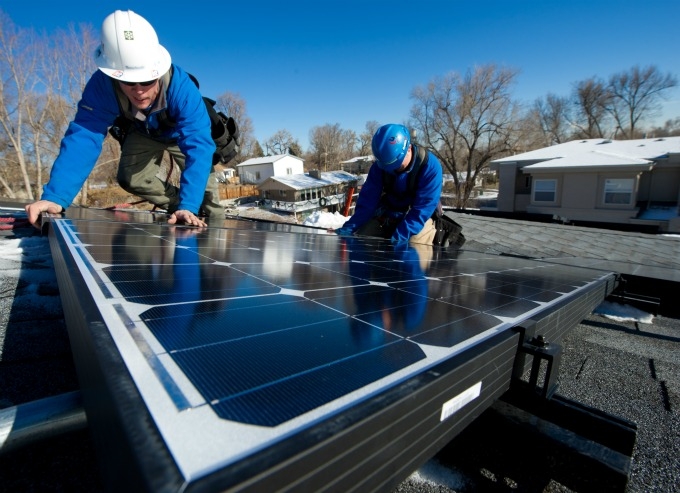Courtesy of the Department of Energy
When choosing a contractor, ask about their work record, experience, and licenses, and get more than one bid for the installation of your PV system. | Photo courtesy of Dennis Schroeder, NREL.
Making sure your home solar electric or photovoltaic (PV) system is sized, sited, installed, and maintained correctly is essential for maximizing its energy performance. When installing a PV system, consider:
- How much sun you have (solar resource)
- How big the system needs to be to meet your electricity needs
- Where the system will be located and how much room it needs (system siting)
- Whether you want your system to be connected to the grid or not
- What needs to be done to ensure that the system is safe.
Therefore, it’s best to have a professional solar contractor install the system. When choosing a contractor, ask yourself the following questions:
- Has the company installed grid-connected PV systems? If not, has it installed grid-independent (or stand-alone) PV systems? Experience in installing grid-connected systems is valuable because some elements of the installation — particularly interconnection with the local utility—are unique to these systems. However, a competent company with off-grid PV experience should not be eliminated just because it has not yet installed grid-connected PV systems. Experience with off-grid systems is valuable too, because grid-independent systems are more technically complex than grid-tied systems.
- How many years of experience does the company have installing PV systems? A contractor who has been in business a long time probably understands how to work with customers and to compete effectively with other firms. Additionally, he/she will probably be aware of the latest code and permitting issues surrounding the installation of PV systems.
- Is the company properly licensed or certified? PV systems should be installed by an appropriately licensed contractor. This usually means that either the installer or a subcontractor has an electrical contractor’s license. Your state electrical board can tell you whether a contractor has a valid electrician’s license.
Local building departments might also require that the installer have a general contractor’s license. Call the city or county where you live for additional information on licensing.
A solar rebate program may require that, in addition to being properly licensed, installers must demonstrate that they have special knowledge about installing PV systems. Special knowledge can be demonstrated through certification by solar industry and/or trade associations. - Does the company have any pending or active judgments or liens against it? As with any project that requires a contractor, due diligence is recommended. Your state electrical board can tell you about any judgments or complaints against a state-licensed electrician. Consumers should call the city and county where they live for information on how to evaluate contractors. The Better Business Bureau is another source of information.
It is always a good idea to get more than one bid for the installation of your PV system. Make sure that all bids are made on the same basis. For example, a bid for a system mounted on the ground is usually very different from another bid for a rooftop system.
Similarly, some PV modules generate more electricity per square foot than others. Bids should clearly state the maximum generating capacity of the system — measured in Watts (W) or kilowatts (kW). If possible, have the bids specify the system capacity in “AC Watts” (alternating current) under a standard set of test conditions, or specify the output of the system at the inverter. Also request an estimate of the amount of energy that the system will produce on an annual basis (measured in kilowatt-hours).
Because the amount of energy depends on the amount of sunlight — which varies by location, season, and year to year — it’s unlikely the contractor will quote a specific figure, but a range of 20% is realistic. Bids also should include the total cost of getting the PV system up and running, including hardware, installation, connection to the grid, permitting, sales tax, and warranty.
Your warranty is also a very important factor for evaluating bids. A solar rebate program may require that systems be covered by a two-year parts-and-labor written installation warranty, for example, in addition to any manufacturers’ warranties on specific components (including inverter and module warranties). The installer may offer longer warranties. Also ask yourself, “Will this company stand behind the full-system warranty for the next two years?”
Maintaining Your Home Solar Electric System
As with any mechanical or electrical appliance, PV systems require routine, periodic maintenance. System components may also need repair or replacement from time to time.
An efficient and long-lasting system will depend on a periodic check of system components and completion of any preventive maintenance as necessary. Talk with your system installer about routine and periodic maintenance. In the event of a system malfunction, effective troubleshooting and repair is necessary.
You may be able to carry out many routine inspections and maintenance tasks yourself. If, however, you are not the do-it-yourself type, or if there is a major problem with your system, you will need to locate a professional to do the work.
Sizing Your Home Solar Electric System
Accurately sizing the components of your solar electric or PV system helps ensure that your system will produce the amount of power you want it to produce. This is especially important for stand-alone systems, which are not connected to the electricity grid. Because PV is modular, you can always add to your solar energy collector should you need more power down the road.
First, consider what portion of your current electricity needs you would like your PV system to meet. For example, suppose that you would like to meet a certain percentage of your electricity needs with your PV system. You could work with your PV provider to examine past electric bills and determine the size of the PV system needed to achieve that goal. You can contact your utility company and request the total electricity usage, measured in kilowatt-hours, for your household or business over the past 12 months or consult your electric bills if you save them.
If you reduce your electricity loads, you can generally buy a smaller, less expensive PV system.
In addition to how much electricity you’d like to generate, the size of your system also depends on these factors:
- The site’s solar resource or available sunlight
- The system’s orientation and tilt
- The system’s efficiency at converting sunlight to electricity
- Other electricity sources, like a utility, a wind turbine, or a fossil fuel generator.
PV systems are classified by their rated power output (the peak power they produce when exposed to solar radiation of 1,000 Watts per square meter at a module temperature of 25°C). Systems rated between 1 and 5 kilowatts are generally sufficient to meet most of the needs of home and small business owners.
The table below provides an estimate of the roof area needed for several systems. Your system supplier/installer can make, or help you make, more precise calculations at your site before you purchase a system.
Roof Area Needed in Square Feet
| PV Module Efficiency (%) | PV Capacity Rating (Watts) | ||||||
| 100 | 250 | 500 | 1,000 | 2,000 | 4,000 | 10,000 | |
| 4 | 30 | 75 | 150 | 300 | 600 | 1,200 | 3,000 |
| 8 | 15 | 38 | 75 | 150 | 300 | 600 | 1,500 |
| 12 | 10 | 25 | 50 | 100 | 200 | 400 | 1,000 |
| 16 | 8 | 20 | 40 | 80 | 160 | 320 | 800 |
For example, to generate 2,000 Watts from a 12%-efficient system, you need 200 square feet of roof area.
Siting Your Small Solar Electric System
Both the orientation and tilt of your solar panels or PV modules will affect the output of your solar electric system. You and your contractor should consider both factors while evaluating your site’s solar resource and sizing your system.
Orientation
PV modules should be oriented geographically to maximize the amount of daily and seasonal solar energy that they receive. In general, the optimum orientation for a PV module in the northern hemisphere is true south. However, your modules can face up to 45 degrees east or west of true south without significantly decreasing its performance.
If you plan to mount the modules on your roof, you’ll also want to consider these factors:
- Roof orientation and condition
- Local landscape features that shade the collector daily or seasonally
- Local weather conditions (foggy mornings or cloudy afternoons) that may affect the optimal orientation and subsequent electricity production of the PV modules.
To be eligible for some rebates, your system must be unshaded between certain hours during certain times of the year. Some states also have laws that establish your right to protect your solar access through the creation of a solar easement.
If a rooftop can’t be used, your solar modules can also be placed on the ground, either on a fixed mount or a “tracking” mount that follows the sun to orient the PV modules.
Tilt
Most PV modules are mounted flat on the roof, and so have the same tilt as the roof. Although the optimal tilt angle for your modules is an angle equal to your latitude, fixing the PV modules flat on an angled roof is generally not a problem. However, because most roofs are pitched at an angle less than the latitude, you and your contractor will need to factor your roof angle into the performance calculations when sizing your system.






